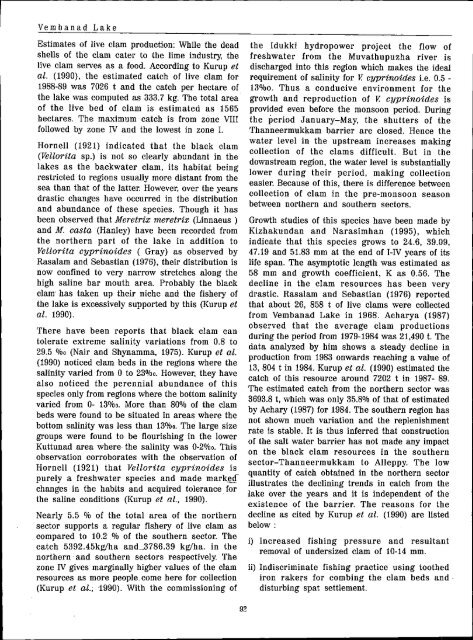06-bioresourcesstatu.. - M. S. Swaminathan Research Foundation
06-bioresourcesstatu.. - M. S. Swaminathan Research Foundation
06-bioresourcesstatu.. - M. S. Swaminathan Research Foundation
Create successful ePaper yourself
Turn your PDF publications into a flip-book with our unique Google optimized e-Paper software.
Vembanad Lake<br />
Estimates of live clam production: While the dead<br />
shells of the clam cater to the lime industry, the<br />
live clam serves as a food. According to Kurup et<br />
al. (1990), the estimated catch of live clam for<br />
1988-89was 7026 t and the catch per hectare of<br />
the lake was computed as 333.7 kg. The total area<br />
of the live bed of clam is estimated as 1565<br />
hectares. The maximum catch is from zone VIII<br />
followed by zone IV and the lowest in zone 1.<br />
Hornell (1921) indicated that the black clam<br />
(Vellorita sp.) is not so clearly abundant in the<br />
lakes as the backwater clam, its habitat being<br />
restricted to regions usually more distant from the<br />
sea than that of the latter. However, over the years<br />
drastic changes have occurred in the distribution<br />
and abundance of these species. Though it has<br />
been observed that Meretrix meretrix (Linnaeus )<br />
and M. casta (Hanley) have been recorded from<br />
the northern part of the lake in addition to<br />
Vellorita cyprinoides ( Gray) as observed by<br />
Rasalam and Sebastian (1976), their distribution is<br />
now confined to very narrow stretches along the<br />
high saline bar mouth area. Probably the black<br />
clam has taken up their niche and the fishery of<br />
the lake is excessively supported by this (Kurup et<br />
al. 1990).<br />
There have been reports that black clam can<br />
tolerate extreme salinity variations from 0.8 to<br />
29.5 %0 (Nair and Shynamma, 1975). Kurup et al.<br />
(1990) noticed clam beds in the regions where the<br />
salinity varied from 0 to 23%0.However, they have<br />
also noticed the perennial abundance of this<br />
species only from regions where the bottom salinity<br />
varied from 0- 13%0.More than 80% of the clam<br />
beds were found to be situated in areas where the<br />
bottom salinity was less than 13%0.The large size<br />
groups were found to be flourishing in the lower<br />
Kuttunad area where the salinity was 0-2%0.This<br />
observation corroborates with the' observation of<br />
Hornell (1921) that Vellorita cyprinoides is<br />
purely a freshwater species and made mark~\!changes<br />
in the habits and acquired tolerance for<br />
the saline conditions (Kurup et al., 1990).<br />
Nearly 5.5 % of the total area of the northern<br />
sector supports a regular fishery of live clam as<br />
compared to 10.2 % of the southern sector. The<br />
catch 5392.45kglha and_3786.39 kglha. in the<br />
northern' and southern sectors respectively. The<br />
zone IV gives marginally higher values of the clam<br />
resources as more people.come here for collection<br />
(Kurup et al.; '1990). With the commissioning of<br />
92<br />
the ldukki hydropower project the flow of<br />
freshwater from the Muvathupuzha river is<br />
discharged into this region which makes the ideal<br />
requirement of salinity for V.cyprinoides i.e. 0.5 -<br />
13%0. Thus a conducive environment for the<br />
growth and reproduction of V. cyprinoides is<br />
provided even before the monsoon period. During<br />
the period January-May, the shutters of the<br />
Thanneermukkam barrier are closed. Hence the<br />
water level in the upstream increases making<br />
collection of the clams difficult. But in the<br />
downstream region, the water level is substantially<br />
lower during their period, making collection<br />
easier. Because of this, there is difference between<br />
collection of clam in the pre-monsoon season<br />
between northern and southern sectors.<br />
Growth studies of this species have been made by<br />
Kizhakundan and Narasimhan (1995), which<br />
indicate that this species grows to 24.6, 39.09,<br />
47.19 and 51.83 mm at the end of I-IV years of its<br />
life span. The asymptotic length was estimated as<br />
58 mm and growth coefficient, K as 0.56. The<br />
decline in the clam resources has been very<br />
drastic. Rasalam and Sebastian (1976) reported<br />
that about 26, 858 t of live clams were collected<br />
from Vembanad Lake in 1968. Acharya (1987)<br />
observed that the average clam productions<br />
during the period from 1979-1984was 21,4901.The<br />
data analyzed by him shows a steady decline in<br />
production from 1983 onwards reaching a value of<br />
13, 804 t in 1984.Kurup et al. (1990) estimated the<br />
catch of this resource around 7202 t in 1987- 89.<br />
The estimated catch from the northern sector was<br />
3693.8t, which was only 35.8% of that of estimated<br />
by Achary (1987) for 1984. The southern region has<br />
not shown much variation and the replenishment<br />
rate is stable. It is thus inferred that construction<br />
of the salt water barrier has not made any impact<br />
on the black clam resources in the southern<br />
sector-Thanneermukkam to Alleppy. The low<br />
quantity of catch obtained in the northern sector<br />
illustrates the declining trends in catch from the<br />
lake over the years and it is independent of the<br />
existence of the barrier. The reasons for the<br />
decline as cited by Kurup et ai. (1990) are listed<br />
below:<br />
i) Increased fishing pressure and resultant<br />
removal of undersized clam of 10-14 mm.<br />
il) Indiscriminate fishing practice using toothed<br />
iron rakers for combing the clam beds and,<br />
disturbing spat settlement.










